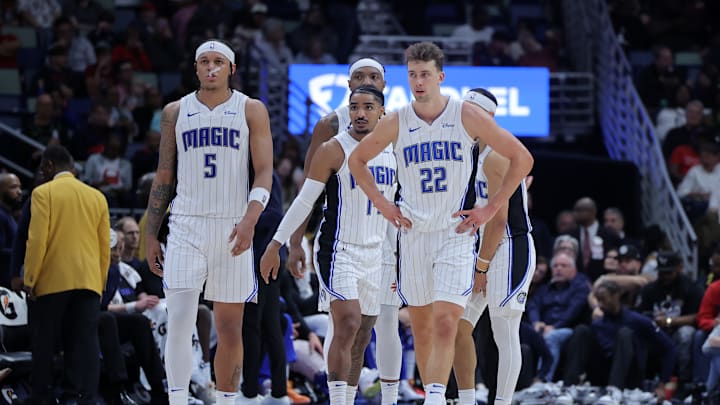One question for every Orlando Magic player heading to the Playoffs
Wendell Carter: What can Carter do to rebound the ball at a higher rate?
The Orlando Magic are surprisingly in the middle tier of the NBA when rebounding the ball.
Wendell Carter averages the most per game at a mere 7.3 boards per game. When looking at the rest of the roster, only Paolo Banchero and Franz Wagner average more than 5.0 rebounds per game.
The team could use some more effort from Carter on the glass as he is averaging the lowest rebounds per game since joining the Magic.
The reduced rebounding is correlated with the more time Carter has spent on the perimeter as a shooting threat.
Carter was drafted to be a rim protector. And the Magic could do with using him closer to the paint a bit more. During his rookie campaign, he averaged 1.3 blocks per contest. His blocking ability has decreased as each season has passed and now averages fewer per game than Jalen Suggs.
As Carter's vertical shot-blocking ability has worsened he needs to focus on rebounding as his calling card. He is 6-foot-10, 270 pounds and still athletic at this size. Rebounding is a skill that can be developed. It is about will, but it is about understanding angles and positioning too.
The good news is Carter has improved his rebounding. Since the All-Star Break (entering Tuesday's game), he is averaging 8.3 rebounds per game. Carter is picking his game up.
That will only become more importnat once the Playoffs begin.
Carter has become a 3&D big man who does a decent job with lateral movement when handling the pick-and-roll and contesting shots. If he can add a new wrinkle to his game and become an elite rebounder with anticipation and effort he can improve Orlando's already terrific defense.
Gary Harris: How can Harris be even better for the starting unit?
The Orlando Magic took another step in their development since the All-Star break when Gary Harris was called upon to start. He shoots it well and limits turnovers while continuing to defend opposing guards at a high level.
The point guard-less lineup has used the primary ball handling of Paolo Banchero and Franz Wagner while Jalen Suggs, Wendell Carter and Gary Harris are spot-up, catch-and-shoot weapons.
On offense, Harris can look to take more shots. When he is in rhythm and is consistently taking threes he makes them at a higher clip. Most shooters do well with more volume as they become comfortable with their role and their shot.
In Harris' career, when he shoots more than 4.0 threes per game he makes them at 39.4 percent. When he shoots fewer than 4.0 per game he converts on 32.7 percent of them. He has split his career with seven seasons with fewer than 4.0 threes per game and six seasons shooting more than 4.0.
This sample size suggests the team will benefit if he increases his efforts to get more shots up.
Entering Tuesday's game, Harris is 37.1 percent on 3.8 attempts per game. The Magic are 17-8 when Harris takes four or more 3-pointers per game. They are also 16-6 when he makes two or more threes in a game.
If Harris can prove to be even more of a threat from behind the arc than he already is, defenses will have to adjust. This will not only provide more scoring potential for the rest of the roster but this adjustment could see Harris knocking down a higher percentage of shots to finish the season.
